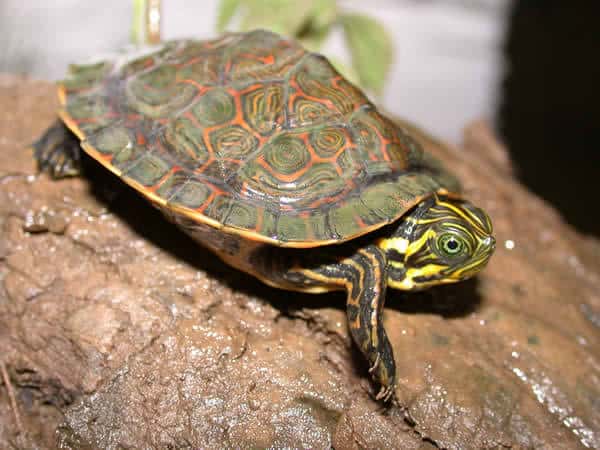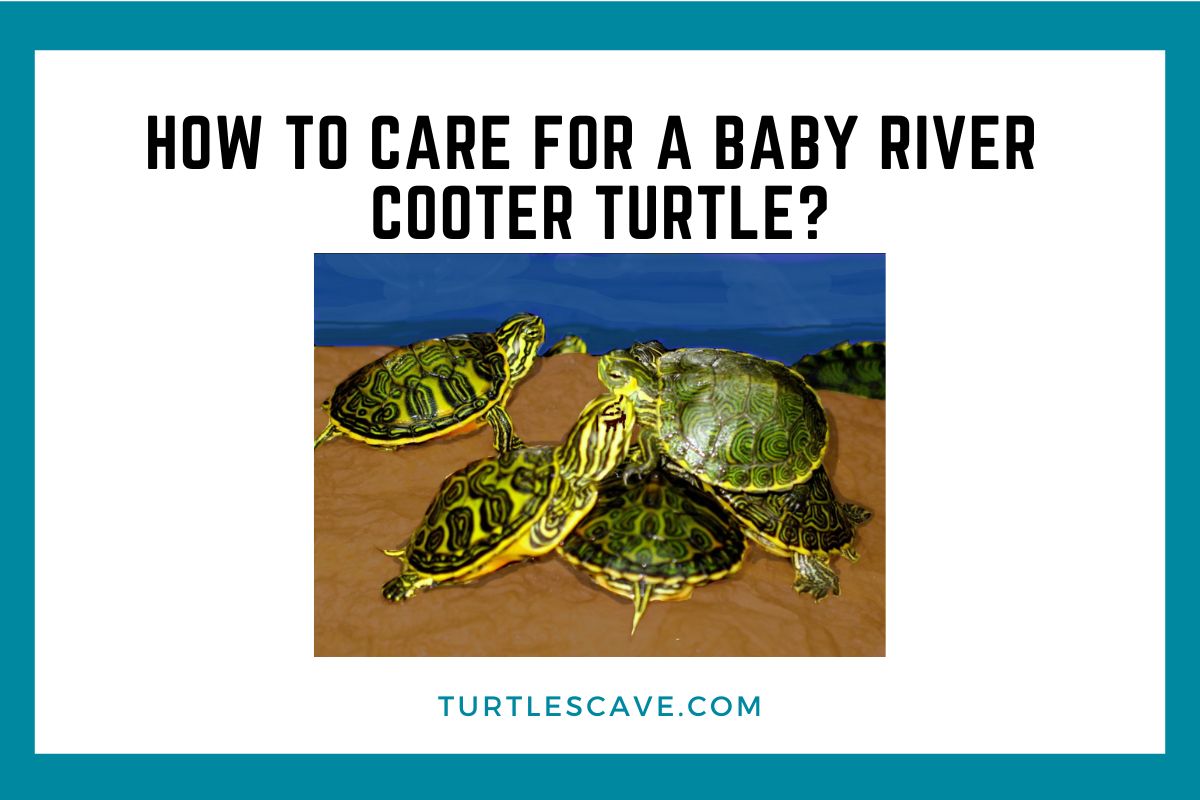To care for a baby river cooter turtle, provide a clean tank, proper heat and lighting, a balanced diet, and regular check-ups with a veterinarian. Taking care of a baby river cooter turtle requires dedication and attention to detail.
These adorable creatures may seem low-maintenance, but they still need specific care to thrive in captivity. In this guide, we will explore the essential aspects of caring for a baby river cooter turtle, ensuring their health and well-being. From creating a clean and suitable enclosure to providing the right temperature and lighting, every element plays a crucial role in their growth.
Additionally, maintaining a balanced diet and regular veterinary check-ups are vital for the optimal development of these small turtles. Let’s dive into the details of how to care for a baby river cooter turtle effectively.

Credit: www.tortoisetown.com
Providing A Suitable Tank For Your Baby River Cooter Turtle
As an owner of a baby river cooter turtle, it is essential to provide a suitable tank that meets their specific needs to ensure their well-being and happiness. Choosing the right size tank, setting up the tank with proper substrate, creating a basking area with a heat source, and maintaining an appropriate water temperature are some key factors to consider.
Let’s explore each aspect in detail:
Choosing The Right Size Tank
- Select a tank that offers enough space for your baby river cooter turtle to swim and roam around comfortably.
- Consider the size of your turtle when purchasing the tank, as they will need a larger space as they grow.
- The general recommendation is to provide at least 10 gallons of water per inch of a shell’s length.
Setting Up The Tank With Proper Substrate
- Use a layer of river sand or small-sized gravel as the substrate at the bottom of the tank.
- Avoid using small stones or gravel that your turtle could swallow and potentially choke on.
- Ensure the substrate is easy to clean and maintain to keep the tank hygienic.
Creating A Basking Area With Heat Source
- Provide a basking area where your baby river cooter turtle can climb out of the water and receive warmth.
- Use a flat rock or basking platform that allows your turtle to bask safely and comfortably.
- Install a heat lamp or a reptile-specific basking lamp above the basking area to provide adequate warmth.
Maintaining Appropriate Water Temperature
- Use a high-quality aquarium heater to maintain a consistent water temperature between 75-80 degrees fahrenheit (24-27 degrees celsius).
- Monitor the temperature regularly to ensure it stays within this optimal range.
- Use a reliable thermometer to accurately measure and maintain the water temperature.
By considering these key aspects and providing a suitable tank for your baby river cooter turtle, you will create a healthy and thriving environment for your little reptile friend. Remember to clean the tank regularly and provide ample hiding spots and enrichment to keep them mentally stimulated.
Your baby turtle will thank you for providing a safe and comfortable space they can call their own.
Creating An Ideal Water Environment For Your Baby River Cooter Turtle
Creating an ideal water environment for your baby river cooter turtle
Establishing a proper filtration system:
- A filtration system is essential for maintaining the water quality in your baby river cooter turtle’s habitat.
- Install a filtration system that can adequately handle the tank size and the amount of waste produced by the turtle.
- A combination of mechanical, biological, and chemical filtration is recommended for optimal water quality.
Maintaining clean water quality:
- Regular water changes are crucial for keeping the water clean and free from harmful substances.
- Change a portion of the water at least once a week, ensuring that the temperature and chemical composition match the existing water.
- Use a siphon to remove debris from the tank bottom during water changes.
- Regularly clean the filter media to prevent clogging and maintain its effectiveness.
Monitoring ph levels and hardness:
- Ph levels and water hardness play a significant role in the overall health of your baby river cooter turtle.
- Use a water test kit to monitor the ph levels and ensure they remain within the recommended range of 6.5 to 8.0.
- Check the water hardness regularly and adjust it to the appropriate range for your turtle’s species.
- Consult a veterinarian or an experienced turtle keeper if you encounter any issues with the water parameters.
Ensuring sufficient water depth for swimming:
- Baby river cooter turtles require an adequate water depth to facilitate swimming and exercise.
- The water depth should be at least two times the turtle’s shell length to allow proper movement.
- Provide a shallow area in the tank where the turtle can easily access the surface to breathe.
- Remember to regularly monitor the water level and adjust it as necessary to maintain the ideal depth for your turtle’s growth.
By following these guidelines and providing your baby river cooter turtle with an ideal water environment, you can ensure their health and well-being. Remember to regularly monitor the water quality, make necessary adjustments, and consult professionals if needed. As responsible turtle keepers, we play a vital role in our turtle’s happiness and longevity.
Understanding The Dietary Needs Of Baby River Cooter Turtles
Caring for a baby river cooter turtle involves ensuring they have a proper diet. These little reptiles have specific dietary needs to support their growth and overall health. Offering a balanced diet of vegetables, commercial turtle pellets, live and frozen foods, while avoiding toxic and harmful foods, will ensure your baby river cooter turtle thrives.
Let’s take a closer look at each aspect of their diet.
Providing A Balanced Diet Of Vegetables
To provide a balanced diet for your baby river cooter turtle, including a variety of vegetables is essential. Some key vegetables to include are:
- Leafy greens: Such as kale, spinach, and dandelion greens, provide essential vitamins and minerals.
- Squash and pumpkin: These vegetables are rich in fiber and help with digestion.
- Carrots and bell peppers: These colorful vegetables are a great source of vitamins and antioxidants.
Offering Commercial Turtle Pellets
Commercial turtle pellets are designed to meet the nutritional needs of baby river cooter turtles. These pellets provide essential nutrients such as protein, vitamins, and minerals. When choosing pellets, opt for ones specifically formulated for aquatic turtles. It is important to follow the recommended feeding guidelines and not overfeed your turtle.
Incorporating Live And Frozen Foods
In addition to vegetables and commercial turtle pellets, incorporating live and frozen foods into your baby river cooter turtle’s diet is beneficial. These foods simulate their natural feeding behaviors and offer additional nutrients. Some examples of live and frozen foods to offer include:
- Mealworms: A good source of protein for your turtle.
- Bloodworms: Rich in nutrients and can be offered as a treat.
- Brine shrimp: A natural food that provides variety in their diet.
Avoiding Toxic And Harmful Foods For Your Turtle
There are certain foods that can be toxic or harmful to baby river cooter turtles. It is crucial to avoid feeding them:
- High-fat foods: Such as cheese and fatty meats, as they can lead to health issues like obesity and organ problems.
- Onions and garlic: These foods can cause anemia in turtles.
- Insects caught in the wild: They may carry parasites or pesticides that can harm your turtle.
Ensuring a proper diet for your baby river cooter turtle is vital for their overall health and well-being. By providing a balanced diet of vegetables, commercial turtle pellets, live and frozen foods, while being mindful of avoiding toxic and harmful foods, you are setting the foundation for a healthy and thriving turtle.
Establishing A Feeding Schedule For Your Baby River Cooter Turtle
Caring for a baby river cooter turtle can be a rewarding experience, but it also requires some knowledge and dedication. One important aspect of caring for your turtle is establishing a feeding schedule. By providing your baby turtle with nutritious meals at the right frequency and portion sizes, you can ensure they grow up healthy and strong.
Here are some key points to consider when setting up a feeding schedule for your baby river cooter turtle:
Determining The Frequency Of Feedings
- Baby river cooter turtles should be fed daily to support their growth and development.
- Young turtles have high metabolisms, so they require frequent meals to fuel their energy needs.
- Offer a mix of commercial turtle pellets, insects, and small pieces of fruits and vegetables to provide a balanced diet.
Monitoring Portion Sizes Based On Age And Size
- Adjust the amount of food given to your baby turtle based on its age and size.
- Offer a portion size that can be consumed within a few minutes to prevent overeating.
- As a general guideline, provide an amount of food equivalent to the size of your turtle’s head.
Adjusting The Diet As Your Turtle Grows
- As your baby river cooter turtle grows, its dietary needs will change.
- Gradually introduce a wider variety of foods, including fish, shrimp, and leafy greens.
- Consult a reptile veterinarian or a knowledgeable pet store for specific dietary recommendations based on your turtle’s species.
By establishing a feeding schedule that takes into account the frequency of feedings, monitoring portion sizes, and adjusting the diet as your turtle grows, you can ensure that your baby river cooter turtle receives the nourishment it needs to thrive.
Remember to provide fresh water for drinking and swimming at all times, and monitor your turtle’s eating habits closely to ensure it is healthy and happy. With proper care and attention, your baby river cooter turtle will grow into a beautiful and fascinating adult.
Ensuring Regular Veterinary Care For Your Baby River Cooter Turtle
The health and well-being of your baby river cooter turtle relies heavily on regular veterinary care. Finding a reptile veterinarian with turtle expertise is essential to ensure proper care for your pet. Here are some key points to consider:
Finding A Reptile Veterinarian With Turtle Expertise:
- Research local veterinarians who specialize in reptiles and specifically have experience with turtles.
- Seek recommendations from fellow reptile owners or online reptile communities.
- Check the qualifications, credentials, and experience of the veterinarian to ensure they are knowledgeable about turtle health and care.
- Consider the location and accessibility of the veterinarian’s clinic to ensure convenient and timely visits.
Scheduling Routine Check-Ups And Examinations:
- Regular veterinary check-ups are crucial for monitoring your baby river cooter turtle’s overall health and detecting any underlying issues.
- Follow the recommended schedule for routine check-ups as advised by your veterinarian. Typically, this is once or twice a year for healthy turtles.
- During these check-ups, the veterinarian will conduct a thorough examination, including checking for proper growth, shell health, and any signs of parasites or infections.
- Routine exams also allow your veterinarian to provide necessary vaccinations or preventive treatments to ensure your turtle stays healthy.
Addressing Any Signs Of Illness Or Injury:
- Keep a close eye on your baby river cooter turtle for any unusual behaviors or signs of illness or injury.
- If you notice any changes such as lack of appetite, lethargy, shell abnormalities, or breathing difficulties, contact your veterinarian immediately.
- Promptly addressing signs of illness or injury can prevent the condition from worsening and increase the chances of successful treatment.
- Your veterinarian will perform a thorough examination to diagnose the problem and develop an appropriate treatment plan, which may include medications, dietary changes, or additional care instructions.
By ensuring regular veterinary care for your baby river cooter turtle, you are taking important steps to maintain their health and well-being. Remember, a knowledgeable and experienced reptile veterinarian is key to providing the best possible care for your turtle.
Promoting Mental And Physical Stimulation
Having a baby river cooter turtle as a pet can be an exciting experience. These adorable little creatures require specific care to ensure their mental and physical stimulation. By providing ample space for exploration and swimming, enriching their environment with safe and interactive toys, and incorporating regular handling and socialization, you can promote the overall well-being of your baby turtle.
Let’s dive into each aspect in more detail.
Providing Ample Space To Explore And Swim:
- Baby river cooter turtles require a spacious habitat that allows them to explore and swim freely.
- Ensure that the tank or enclosure you provide is large enough to accommodate their growth and provides ample water to swim.
- The ideal temperature for the water should be around 75-80 degrees fahrenheit to create a comfortable and stimulating environment.
- Incorporate a basking area where the turtle can rest and soak up the warmth of a heat lamp or uvb light.
Enriching The Environment With Safe And Interactive Toys:
- Adding safe and interactive toys to the turtle’s habitat can encourage mental stimulation and prevent them from getting bored.
- Choose toys that are specifically designed for turtles, such as floating or sinking objects, puzzles, or even tunnels.
- Avoid using small objects that may pose a choking hazard and ensure that all toys are non-toxic.
- Rotate and introduce new toys periodically to keep the turtle engaged and curious.
Incorporating Regular Handling And Socialization:
- Regular handling is essential for baby river cooter turtles to become comfortable and accustomed to human interaction.
- Gradually introduce handling by starting with short sessions and gradually increasing the duration.
- Gently hold the turtle, supporting its body and avoiding any force or rough handling.
- Socialize your turtle with other family members or other pets in a controlled and supervised manner to expose them to different stimuli.
By following these tips for promoting mental and physical stimulation, you can ensure that your baby river cooter turtle thrives in a healthy and happy environment. Remember, each turtle is unique, so observe their behavior and adjust their care accordingly.
With the right care, your turtle will grow into a healthy and vibrant companion for years to come.
Frequently Asked Questions Of How To Care For A Baby River Cooter Turtle
How Often Should I Feed My Baby River Cooter Turtle?
To ensure your turtle’s health, feed them once a day. Offer a balanced diet, including commercial turtle food, vegetables, and occasional live or freeze-dried insects. Adjust the portion size based on their appetite and prevent overfeeding, as it can lead to obesity and other health issues.
What Temperature Should The Turtle’S Habitat Be Kept At?
Maintain a water temperature of around 75-80 degrees fahrenheit (24-27 degrees celsius) in the tank. Use an underwater heater or a heat lamp to achieve the desired temperature. Also, provide a basking spot where your turtle can access a higher temperature of 85-90 degrees fahrenheit (29-32 degrees celsius).
How Often Should I Clean The Turtle’S Tank?
Regularly clean your turtle’s tank to maintain water quality. Partial water changes of 25% weekly are usually sufficient for baby turtle tanks. Monitor the water conditions using a test kit, and perform more frequent water changes if necessary. Additionally, remove any uneaten food or waste to keep the tank clean.
Can I Handle My Baby River Cooter Turtle Often?
While handling your turtle occasionally is fine, excessive handling can cause stress and may disrupt their natural behaviors. Limit handling to short periods and avoid picking up your turtle too frequently. Allow them to explore their habitat and provide hiding spots to ensure they feel secure in their environment.
How Big Should The Tank Be For A Baby River Cooter Turtle?
A 20-gallon tank is a suitable size for a baby river cooter turtle initially. As your turtle grows, consider upgrading to a larger tank to provide enough space for optimal movement. Remember to include a basking area, proper filtration, and aquatic plants to create a stimulating habitat.
Is It Necessary To Provide Uvb Lighting For My Baby Turtle?
Yes, it is essential to provide uvb lighting for your baby river cooter turtle. Uvb light helps them produce vitamin d3, which aids in calcium absorption for healthy shell and bone development. Use a uvb reptile lamp designed for aquatic turtles, ensuring it covers the basking area, to provide the necessary uvb spectrum.
Conclusion
Caring for a baby river cooter turtle requires attention to several key aspects of their well-being. By ensuring a suitable habitat with proper temperature and humidity levels, these turtles can thrive. Providing a balanced diet that includes both commercial turtle food and fresh greens is crucial for their nutritional needs.
Regular cleaning of their enclosure and monitoring for any signs of illness or stress will help maintain their health. Additionally, creating a stimulating environment with hiding spots and objects for them to explore and interact with is essential for their mental and physical stimulation.
Remember to handle them gently and avoid overhandling to minimize stress. Overall, by following these guidelines and maintaining a responsible and loving approach to caring for your baby river cooter turtle, you can provide them with a happy and healthy life.
Recent Posts
Hermann tortoises can eat watermelon, but only in moderation. This fruit should not be a staple in their diet due to its high sugar content. Hermann tortoises are fascinating creatures that...
Turtles headbutt black things due to their instinctual response to threats or territorial disputes. When turtles encounter black objects, they may perceive them as intruders or competitors, leading...

